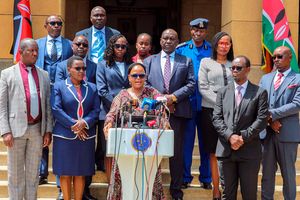How Covid-19 vaccines race led to the isolation of poor nations

A Medic administers a Covid-19 vaccine at the Kenya Medical Practitioners and Dentists Council headquarters in Nairobi on March 31, 2021.
The race to give the world a Covid-19 vaccine has been tight, chaotic, painful and scandalous. There is nothing good to write home about because only five per cent of Africa is vaccinated.
“Of the 128 million vaccine doses administered so far, more than three quarters of those vaccinations are in just 10 countries that account for 60 per cent of global GDP. As of today, almost 130 countries, with 2.5 billion people, are yet to administer a single dose,” the United Nations Children’s Fund (Unicef) pointed out in February this year.
The UN agency termed this a self-defeating strategy that will cost lives and livelihoods, give the virus further opportunity to mutate and evade vaccines, thus undermining global economic recovery.
Earlier this year Mr Anurag Srivastava, the spokesperson of Indian External Affairs, said millions of batches of an Indian Covid-19 vaccine had been dispatched to Mauritius and Seychelles in an initiative known as “Neighbours First”. The programme targeted India’s immediate allies in the region including Nepal, Myanmar, Sri Lanka and Bangladesh, though analysts were of the opinion that the distribution to the two African island nations could end up benefiting the entire mainland Africa.
However, the Delta variant happened and India shut down all vaccine exports, including their “vaccine maitri” (Hindi for vaccine friendship programme), which used the jab as a diplomatic tool to foster relations with countries such as Kenya, which received 100,000 AstraZeneca doses from the Asian country.
The race for the vaccine was on, with the jab used as a weapon. And, just like in any race, there are horses and donkeys. India is vital because, despite producing six in every 10 vaccines for diseases around the world including polio, yellow fever and malaria—diseases common in Africa—the country entered the Covid-19 vaccine race behind the United Kingdom ( UK), United States (US), Russia and China .
Two weeks earlier, the African Union (AU) had announced an order of 270 million doses of Covid-19 vaccines after a deal with Serum Institute of India (SII), and in October 2020, India and South Africa submitted a landmark proposal to the World Trade Organisation (WTO), asking for an ease on the rules that impose intellectual property (IP) barriers, especially on new vaccines, tools and equipment.
SII said it had already produced 11 million doses for Indians, 53 million doses available in stocks and cleared for distribution and another 25 million meant for export was to be ready by January 31 this year.
The UK was game.
“Kenya has joined the global efforts in search of an effective vaccine for Covid-19 with the start of a trial evaluating the ChAdOx1 nCoV-2019 Oxford coronavirus vaccine,” Oxford University announced in an official statement.
‘We’re excited to see our colleagues in Kenya today joining those around the world in helping us to evaluate the ChAdOx1 nCov-2019 Oxford coronavirus vaccine, as it is important to evaluate the vaccine in as many different populations as possible,’ Prof Andy Pollard, the director of the Oxford Vaccine Group and chief investigator of the Oxford Vaccine Trial explained.
This meant that the country had joined the UK, South Africa and Brazil, which were running trials to evaluate the ChAdOx1 nCoV-19 vaccine. The trial was hosted at the Kenya Medical Research Institute (Kemri), specifically, the Kilifi-based Kemri-Wellcome Trust Research Programme, after approvals from regulators, which would see Kenyans become the first volunteers for the Covid-19 AstraZeneca vaccine trials.
Peddled as the “vaccine for the world” and costing one-tenth of what some of its rivals cost and licensed to other manufacturers around the globe to amplify its production, experts believed AstraZeneca was going to be the backbone of Covax, the international vaccine-sharing mechanism and the primary vaccine for low and middle-income countries, with the makers setting a target of inoculating two billion people by 2021.
However, controversies would present a major stumbling block, from fake news on the effects of the jab, to Canada, a G7 country sitting among low-income countries at Covax, hoarding AstraZeneca doses, to the UK trying to arm-twist India to deliver the doses SII was manufacturing in their deal with AstraZeneca to the UK, among others.
America was not left behind, showing up with Moderna and Pfizer vaccines that came with an almost perfect efficacy of as high as 95 per cent. Russia, meanwhile, was busy warming up its Sputnik V Covid-19 vaccine, which President Vladimir Putin launched while claiming to have won the vaccine race.
Even with the emergence of the Omicron variant, the vaccines race is still on, with countries working to provide a solution to this pandemic. The WHO vaccine moratorium is still in place.
“We have seen an increase in supply as a result, with WHO’s Strategic Advisory Group of Experts (Sage) recently highlighting the need to continue to focus on high risk groups while saying that boosters are recommended for immunocompromised people and not young people,” Dr Richard Mihigo, the Immunization and Vaccines Development Program Coordinator at WHO Africa Region told the Nation this December.





